Woolworths Limited: Analyzing the Impact of AASB 16 on Leases
VerifiedAdded on 2023/06/12
|14
|3298
|199
Report
AI Summary
This report evaluates lease agreements and their impact on financial reports, focusing on Woolworths Limited and the effects of AASB 16. It contrasts operating and financial leases, examines Woolworths' leasing practices, and analyzes the short and long-term impacts of AASB 16 on the company's financial statements and gearing ratios. The report highlights that AASB 16's implementation will likely increase Woolworths' profit before tax due to the treatment of off-balance sheet leases. Furthermore, it discusses the broader implications of AASB 16 on the Australian retail industry, noting potential increases in debt and EBITDA, with a particularly significant impact on the retail sector. The report also explores the rationale behind the IASB's viewpoint on lease accounting and addresses concerns regarding increased debt and the lack of a level playing field among companies.
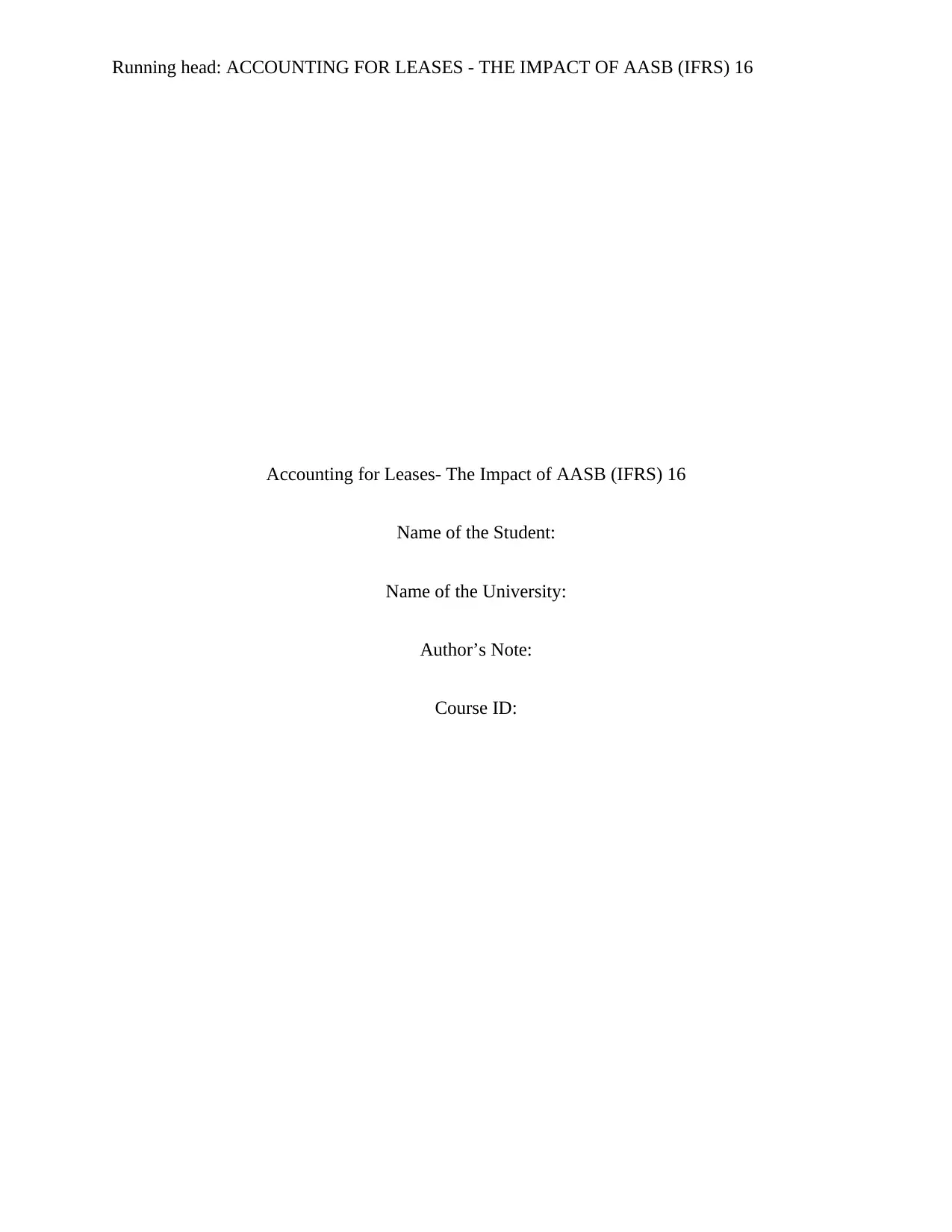
Running head: ACCOUNTING FOR LEASES - THE IMPACT OF AASB (IFRS) 16
Accounting for Leases- The Impact of AASB (IFRS) 16
Name of the Student:
Name of the University:
Author’s Note:
Course ID:
Accounting for Leases- The Impact of AASB (IFRS) 16
Name of the Student:
Name of the University:
Author’s Note:
Course ID:
Paraphrase This Document
Need a fresh take? Get an instant paraphrase of this document with our AI Paraphraser
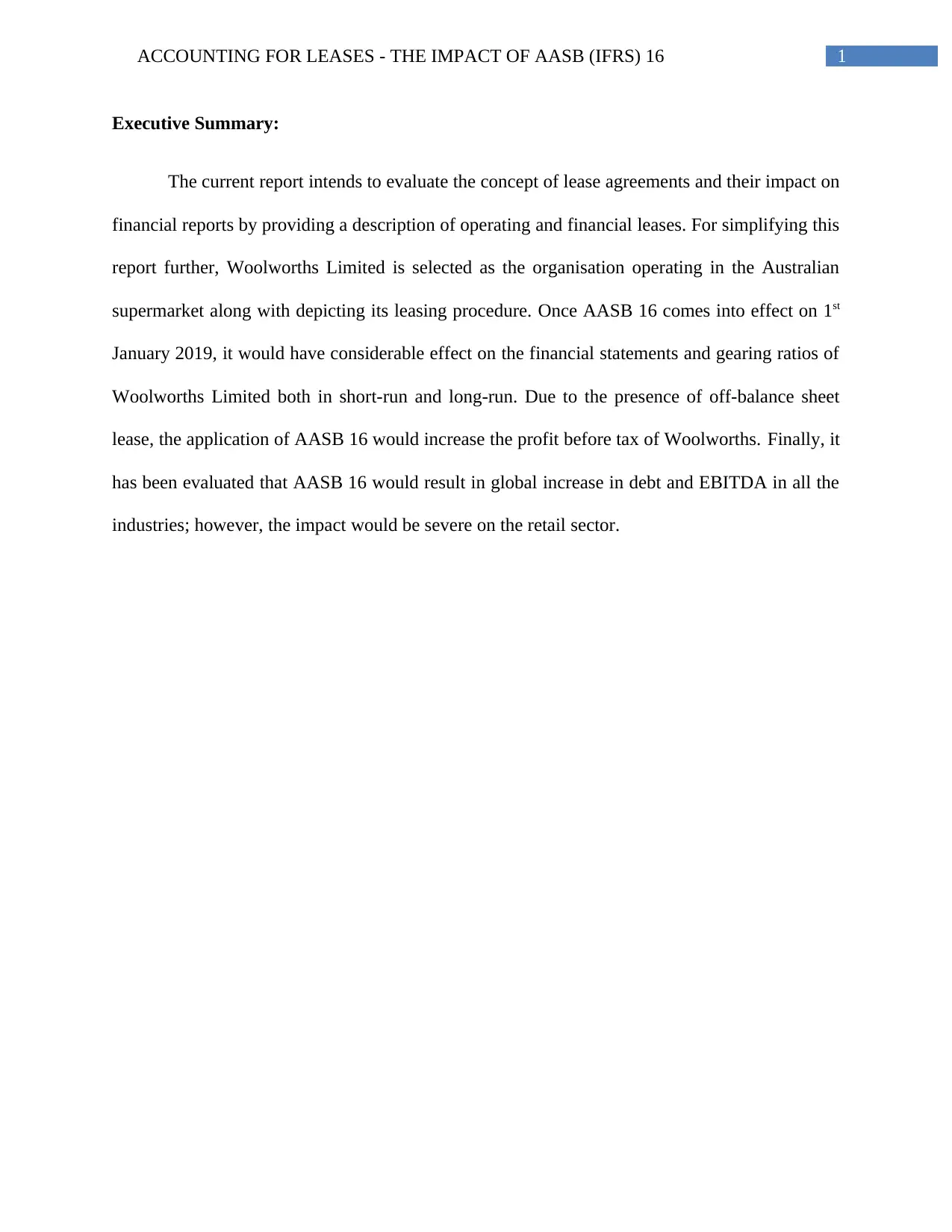
1ACCOUNTING FOR LEASES - THE IMPACT OF AASB (IFRS) 16
Executive Summary:
The current report intends to evaluate the concept of lease agreements and their impact on
financial reports by providing a description of operating and financial leases. For simplifying this
report further, Woolworths Limited is selected as the organisation operating in the Australian
supermarket along with depicting its leasing procedure. Once AASB 16 comes into effect on 1st
January 2019, it would have considerable effect on the financial statements and gearing ratios of
Woolworths Limited both in short-run and long-run. Due to the presence of off-balance sheet
lease, the application of AASB 16 would increase the profit before tax of Woolworths. Finally, it
has been evaluated that AASB 16 would result in global increase in debt and EBITDA in all the
industries; however, the impact would be severe on the retail sector.
Executive Summary:
The current report intends to evaluate the concept of lease agreements and their impact on
financial reports by providing a description of operating and financial leases. For simplifying this
report further, Woolworths Limited is selected as the organisation operating in the Australian
supermarket along with depicting its leasing procedure. Once AASB 16 comes into effect on 1st
January 2019, it would have considerable effect on the financial statements and gearing ratios of
Woolworths Limited both in short-run and long-run. Due to the presence of off-balance sheet
lease, the application of AASB 16 would increase the profit before tax of Woolworths. Finally, it
has been evaluated that AASB 16 would result in global increase in debt and EBITDA in all the
industries; however, the impact would be severe on the retail sector.
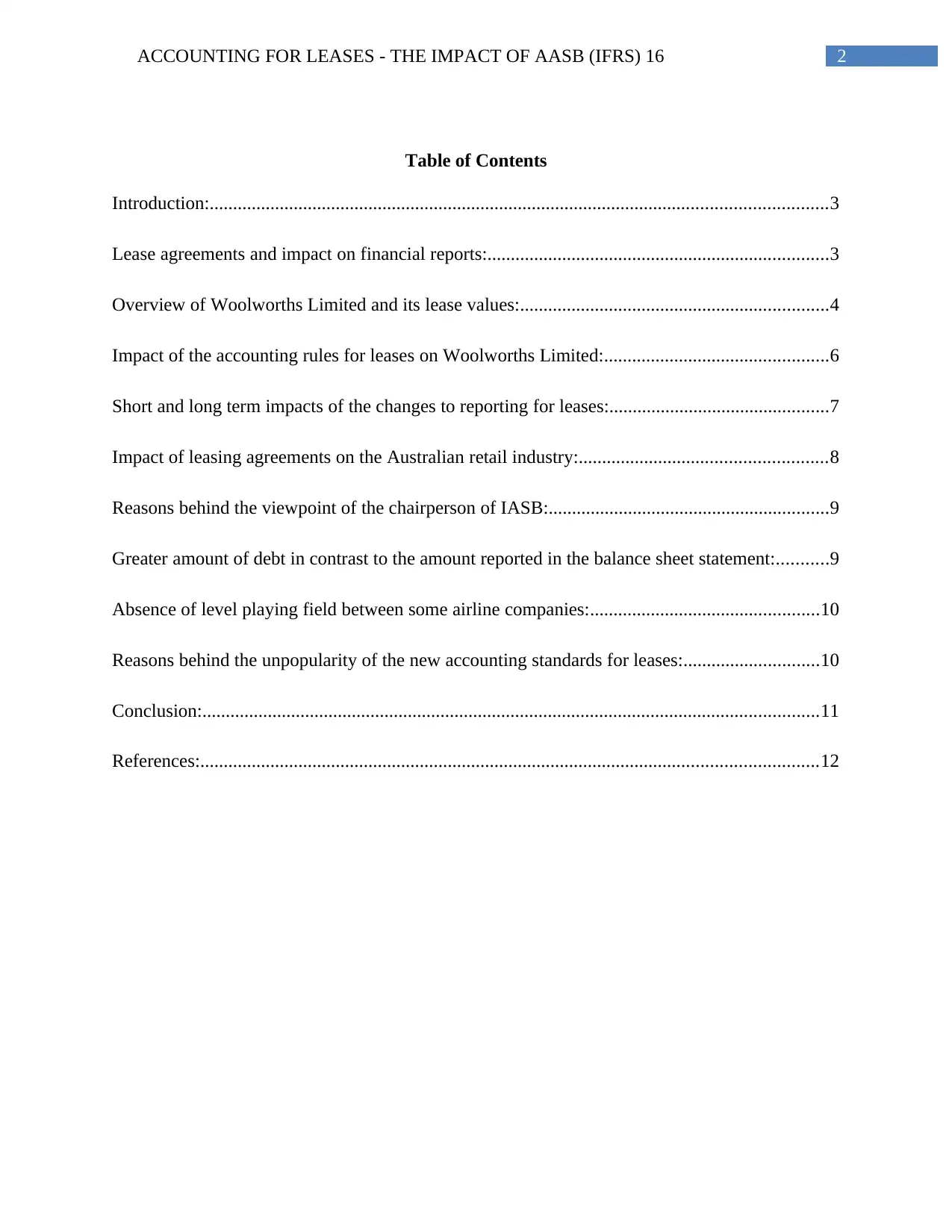
2ACCOUNTING FOR LEASES - THE IMPACT OF AASB (IFRS) 16
Table of Contents
Introduction:....................................................................................................................................3
Lease agreements and impact on financial reports:.........................................................................3
Overview of Woolworths Limited and its lease values:..................................................................4
Impact of the accounting rules for leases on Woolworths Limited:................................................6
Short and long term impacts of the changes to reporting for leases:...............................................7
Impact of leasing agreements on the Australian retail industry:.....................................................8
Reasons behind the viewpoint of the chairperson of IASB:............................................................9
Greater amount of debt in contrast to the amount reported in the balance sheet statement:...........9
Absence of level playing field between some airline companies:.................................................10
Reasons behind the unpopularity of the new accounting standards for leases:.............................10
Conclusion:....................................................................................................................................11
References:....................................................................................................................................12
Table of Contents
Introduction:....................................................................................................................................3
Lease agreements and impact on financial reports:.........................................................................3
Overview of Woolworths Limited and its lease values:..................................................................4
Impact of the accounting rules for leases on Woolworths Limited:................................................6
Short and long term impacts of the changes to reporting for leases:...............................................7
Impact of leasing agreements on the Australian retail industry:.....................................................8
Reasons behind the viewpoint of the chairperson of IASB:............................................................9
Greater amount of debt in contrast to the amount reported in the balance sheet statement:...........9
Absence of level playing field between some airline companies:.................................................10
Reasons behind the unpopularity of the new accounting standards for leases:.............................10
Conclusion:....................................................................................................................................11
References:....................................................................................................................................12
⊘ This is a preview!⊘
Do you want full access?
Subscribe today to unlock all pages.

Trusted by 1+ million students worldwide
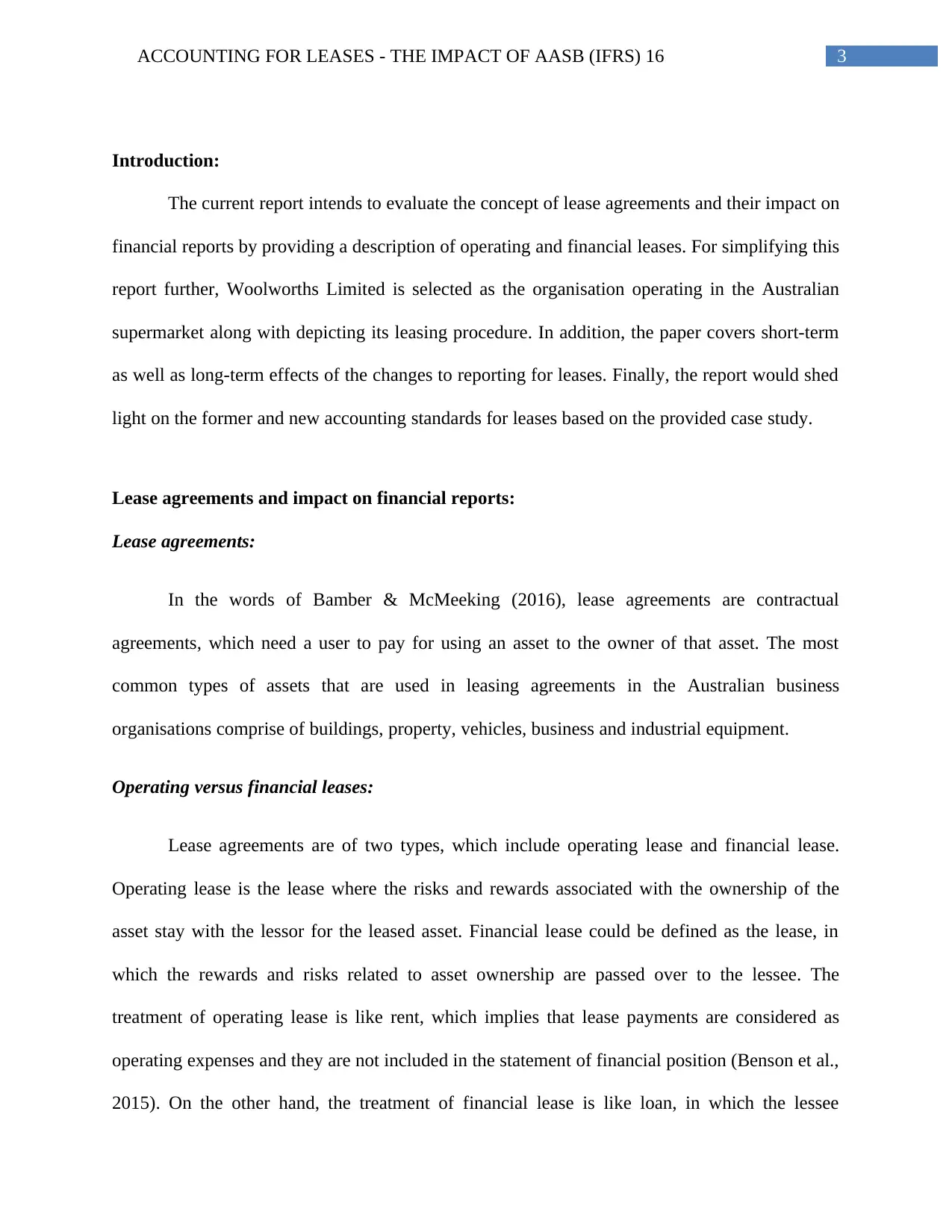
3ACCOUNTING FOR LEASES - THE IMPACT OF AASB (IFRS) 16
Introduction:
The current report intends to evaluate the concept of lease agreements and their impact on
financial reports by providing a description of operating and financial leases. For simplifying this
report further, Woolworths Limited is selected as the organisation operating in the Australian
supermarket along with depicting its leasing procedure. In addition, the paper covers short-term
as well as long-term effects of the changes to reporting for leases. Finally, the report would shed
light on the former and new accounting standards for leases based on the provided case study.
Lease agreements and impact on financial reports:
Lease agreements:
In the words of Bamber & McMeeking (2016), lease agreements are contractual
agreements, which need a user to pay for using an asset to the owner of that asset. The most
common types of assets that are used in leasing agreements in the Australian business
organisations comprise of buildings, property, vehicles, business and industrial equipment.
Operating versus financial leases:
Lease agreements are of two types, which include operating lease and financial lease.
Operating lease is the lease where the risks and rewards associated with the ownership of the
asset stay with the lessor for the leased asset. Financial lease could be defined as the lease, in
which the rewards and risks related to asset ownership are passed over to the lessee. The
treatment of operating lease is like rent, which implies that lease payments are considered as
operating expenses and they are not included in the statement of financial position (Benson et al.,
2015). On the other hand, the treatment of financial lease is like loan, in which the lessee
Introduction:
The current report intends to evaluate the concept of lease agreements and their impact on
financial reports by providing a description of operating and financial leases. For simplifying this
report further, Woolworths Limited is selected as the organisation operating in the Australian
supermarket along with depicting its leasing procedure. In addition, the paper covers short-term
as well as long-term effects of the changes to reporting for leases. Finally, the report would shed
light on the former and new accounting standards for leases based on the provided case study.
Lease agreements and impact on financial reports:
Lease agreements:
In the words of Bamber & McMeeking (2016), lease agreements are contractual
agreements, which need a user to pay for using an asset to the owner of that asset. The most
common types of assets that are used in leasing agreements in the Australian business
organisations comprise of buildings, property, vehicles, business and industrial equipment.
Operating versus financial leases:
Lease agreements are of two types, which include operating lease and financial lease.
Operating lease is the lease where the risks and rewards associated with the ownership of the
asset stay with the lessor for the leased asset. Financial lease could be defined as the lease, in
which the rewards and risks related to asset ownership are passed over to the lessee. The
treatment of operating lease is like rent, which implies that lease payments are considered as
operating expenses and they are not included in the statement of financial position (Benson et al.,
2015). On the other hand, the treatment of financial lease is like loan, in which the lessee
Paraphrase This Document
Need a fresh take? Get an instant paraphrase of this document with our AI Paraphraser
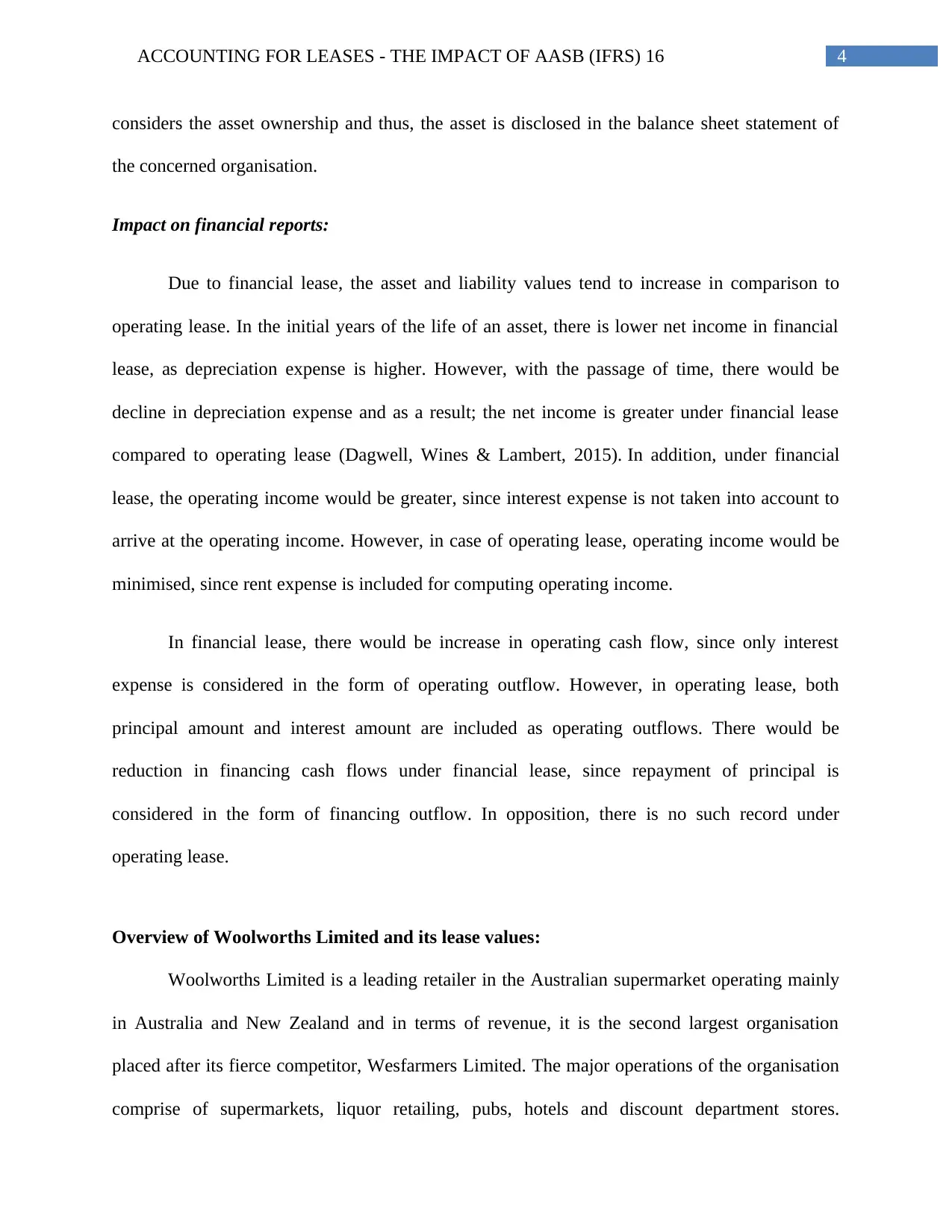
4ACCOUNTING FOR LEASES - THE IMPACT OF AASB (IFRS) 16
considers the asset ownership and thus, the asset is disclosed in the balance sheet statement of
the concerned organisation.
Impact on financial reports:
Due to financial lease, the asset and liability values tend to increase in comparison to
operating lease. In the initial years of the life of an asset, there is lower net income in financial
lease, as depreciation expense is higher. However, with the passage of time, there would be
decline in depreciation expense and as a result; the net income is greater under financial lease
compared to operating lease (Dagwell, Wines & Lambert, 2015). In addition, under financial
lease, the operating income would be greater, since interest expense is not taken into account to
arrive at the operating income. However, in case of operating lease, operating income would be
minimised, since rent expense is included for computing operating income.
In financial lease, there would be increase in operating cash flow, since only interest
expense is considered in the form of operating outflow. However, in operating lease, both
principal amount and interest amount are included as operating outflows. There would be
reduction in financing cash flows under financial lease, since repayment of principal is
considered in the form of financing outflow. In opposition, there is no such record under
operating lease.
Overview of Woolworths Limited and its lease values:
Woolworths Limited is a leading retailer in the Australian supermarket operating mainly
in Australia and New Zealand and in terms of revenue, it is the second largest organisation
placed after its fierce competitor, Wesfarmers Limited. The major operations of the organisation
comprise of supermarkets, liquor retailing, pubs, hotels and discount department stores.
considers the asset ownership and thus, the asset is disclosed in the balance sheet statement of
the concerned organisation.
Impact on financial reports:
Due to financial lease, the asset and liability values tend to increase in comparison to
operating lease. In the initial years of the life of an asset, there is lower net income in financial
lease, as depreciation expense is higher. However, with the passage of time, there would be
decline in depreciation expense and as a result; the net income is greater under financial lease
compared to operating lease (Dagwell, Wines & Lambert, 2015). In addition, under financial
lease, the operating income would be greater, since interest expense is not taken into account to
arrive at the operating income. However, in case of operating lease, operating income would be
minimised, since rent expense is included for computing operating income.
In financial lease, there would be increase in operating cash flow, since only interest
expense is considered in the form of operating outflow. However, in operating lease, both
principal amount and interest amount are included as operating outflows. There would be
reduction in financing cash flows under financial lease, since repayment of principal is
considered in the form of financing outflow. In opposition, there is no such record under
operating lease.
Overview of Woolworths Limited and its lease values:
Woolworths Limited is a leading retailer in the Australian supermarket operating mainly
in Australia and New Zealand and in terms of revenue, it is the second largest organisation
placed after its fierce competitor, Wesfarmers Limited. The major operations of the organisation
comprise of supermarkets, liquor retailing, pubs, hotels and discount department stores.
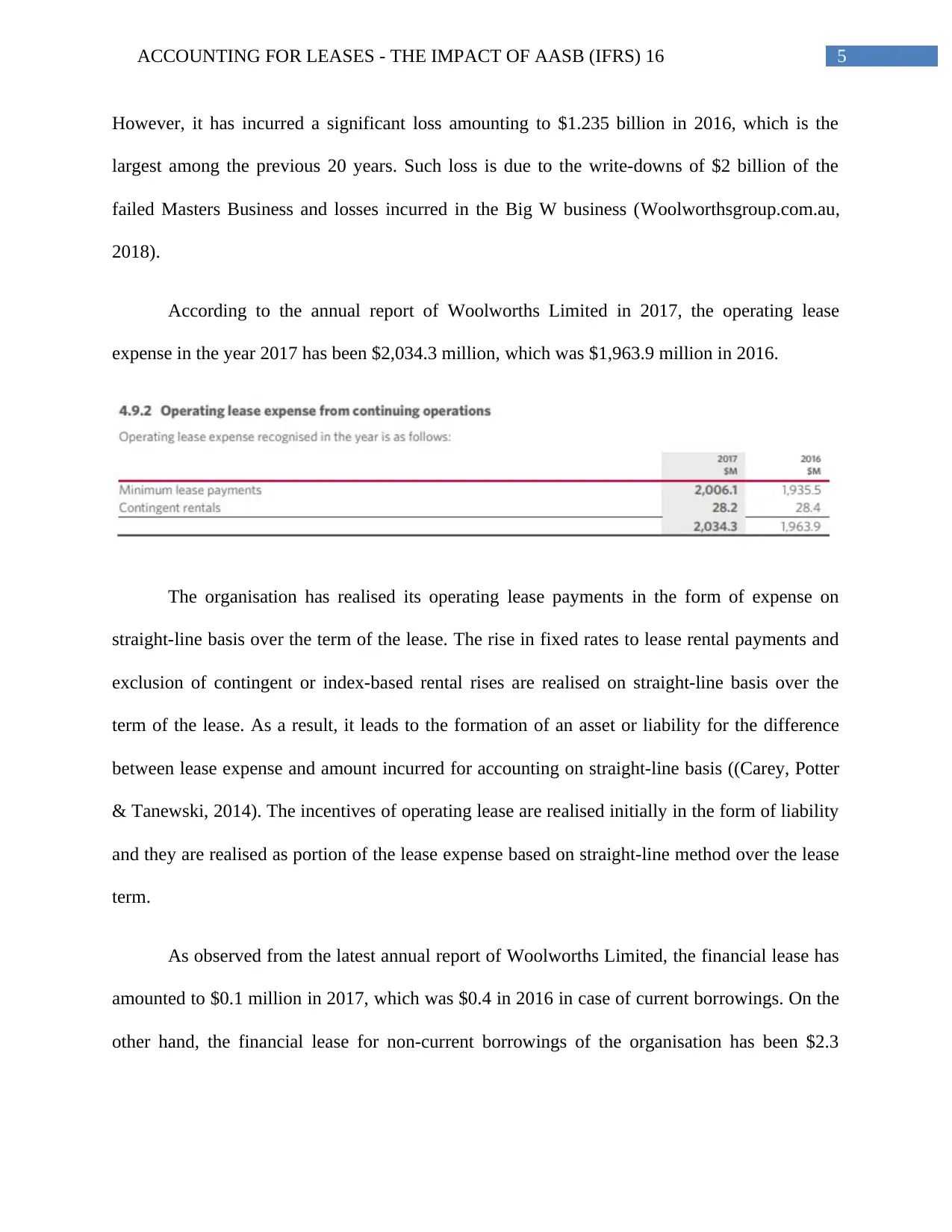
5ACCOUNTING FOR LEASES - THE IMPACT OF AASB (IFRS) 16
However, it has incurred a significant loss amounting to $1.235 billion in 2016, which is the
largest among the previous 20 years. Such loss is due to the write-downs of $2 billion of the
failed Masters Business and losses incurred in the Big W business (Woolworthsgroup.com.au,
2018).
According to the annual report of Woolworths Limited in 2017, the operating lease
expense in the year 2017 has been $2,034.3 million, which was $1,963.9 million in 2016.
The organisation has realised its operating lease payments in the form of expense on
straight-line basis over the term of the lease. The rise in fixed rates to lease rental payments and
exclusion of contingent or index-based rental rises are realised on straight-line basis over the
term of the lease. As a result, it leads to the formation of an asset or liability for the difference
between lease expense and amount incurred for accounting on straight-line basis ((Carey, Potter
& Tanewski, 2014). The incentives of operating lease are realised initially in the form of liability
and they are realised as portion of the lease expense based on straight-line method over the lease
term.
As observed from the latest annual report of Woolworths Limited, the financial lease has
amounted to $0.1 million in 2017, which was $0.4 in 2016 in case of current borrowings. On the
other hand, the financial lease for non-current borrowings of the organisation has been $2.3
However, it has incurred a significant loss amounting to $1.235 billion in 2016, which is the
largest among the previous 20 years. Such loss is due to the write-downs of $2 billion of the
failed Masters Business and losses incurred in the Big W business (Woolworthsgroup.com.au,
2018).
According to the annual report of Woolworths Limited in 2017, the operating lease
expense in the year 2017 has been $2,034.3 million, which was $1,963.9 million in 2016.
The organisation has realised its operating lease payments in the form of expense on
straight-line basis over the term of the lease. The rise in fixed rates to lease rental payments and
exclusion of contingent or index-based rental rises are realised on straight-line basis over the
term of the lease. As a result, it leads to the formation of an asset or liability for the difference
between lease expense and amount incurred for accounting on straight-line basis ((Carey, Potter
& Tanewski, 2014). The incentives of operating lease are realised initially in the form of liability
and they are realised as portion of the lease expense based on straight-line method over the lease
term.
As observed from the latest annual report of Woolworths Limited, the financial lease has
amounted to $0.1 million in 2017, which was $0.4 in 2016 in case of current borrowings. On the
other hand, the financial lease for non-current borrowings of the organisation has been $2.3
⊘ This is a preview!⊘
Do you want full access?
Subscribe today to unlock all pages.

Trusted by 1+ million students worldwide
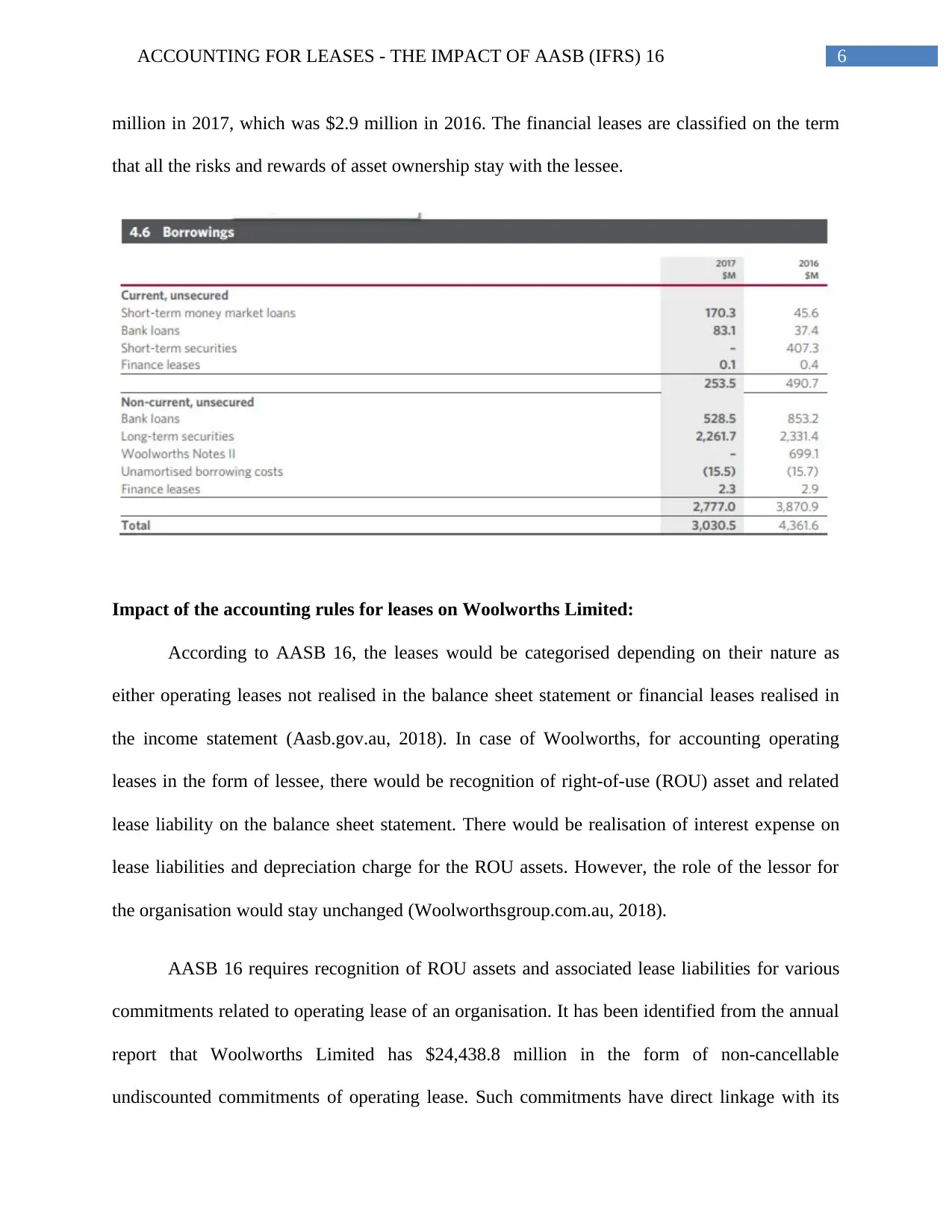
6ACCOUNTING FOR LEASES - THE IMPACT OF AASB (IFRS) 16
million in 2017, which was $2.9 million in 2016. The financial leases are classified on the term
that all the risks and rewards of asset ownership stay with the lessee.
Impact of the accounting rules for leases on Woolworths Limited:
According to AASB 16, the leases would be categorised depending on their nature as
either operating leases not realised in the balance sheet statement or financial leases realised in
the income statement (Aasb.gov.au, 2018). In case of Woolworths, for accounting operating
leases in the form of lessee, there would be recognition of right-of-use (ROU) asset and related
lease liability on the balance sheet statement. There would be realisation of interest expense on
lease liabilities and depreciation charge for the ROU assets. However, the role of the lessor for
the organisation would stay unchanged (Woolworthsgroup.com.au, 2018).
AASB 16 requires recognition of ROU assets and associated lease liabilities for various
commitments related to operating lease of an organisation. It has been identified from the annual
report that Woolworths Limited has $24,438.8 million in the form of non-cancellable
undiscounted commitments of operating lease. Such commitments have direct linkage with its
million in 2017, which was $2.9 million in 2016. The financial leases are classified on the term
that all the risks and rewards of asset ownership stay with the lessee.
Impact of the accounting rules for leases on Woolworths Limited:
According to AASB 16, the leases would be categorised depending on their nature as
either operating leases not realised in the balance sheet statement or financial leases realised in
the income statement (Aasb.gov.au, 2018). In case of Woolworths, for accounting operating
leases in the form of lessee, there would be recognition of right-of-use (ROU) asset and related
lease liability on the balance sheet statement. There would be realisation of interest expense on
lease liabilities and depreciation charge for the ROU assets. However, the role of the lessor for
the organisation would stay unchanged (Woolworthsgroup.com.au, 2018).
AASB 16 requires recognition of ROU assets and associated lease liabilities for various
commitments related to operating lease of an organisation. It has been identified from the annual
report that Woolworths Limited has $24,438.8 million in the form of non-cancellable
undiscounted commitments of operating lease. Such commitments have direct linkage with its
Paraphrase This Document
Need a fresh take? Get an instant paraphrase of this document with our AI Paraphraser
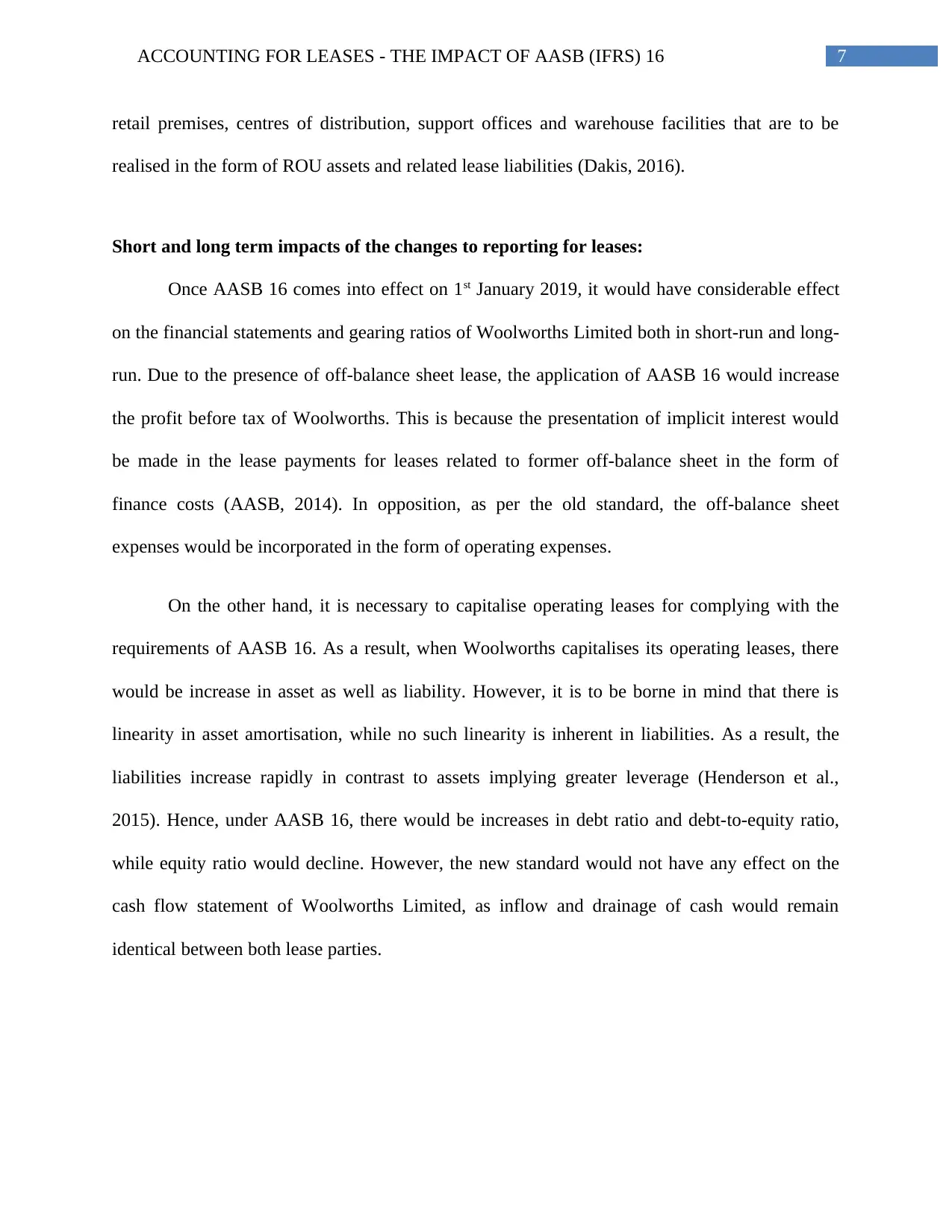
7ACCOUNTING FOR LEASES - THE IMPACT OF AASB (IFRS) 16
retail premises, centres of distribution, support offices and warehouse facilities that are to be
realised in the form of ROU assets and related lease liabilities (Dakis, 2016).
Short and long term impacts of the changes to reporting for leases:
Once AASB 16 comes into effect on 1st January 2019, it would have considerable effect
on the financial statements and gearing ratios of Woolworths Limited both in short-run and long-
run. Due to the presence of off-balance sheet lease, the application of AASB 16 would increase
the profit before tax of Woolworths. This is because the presentation of implicit interest would
be made in the lease payments for leases related to former off-balance sheet in the form of
finance costs (AASB, 2014). In opposition, as per the old standard, the off-balance sheet
expenses would be incorporated in the form of operating expenses.
On the other hand, it is necessary to capitalise operating leases for complying with the
requirements of AASB 16. As a result, when Woolworths capitalises its operating leases, there
would be increase in asset as well as liability. However, it is to be borne in mind that there is
linearity in asset amortisation, while no such linearity is inherent in liabilities. As a result, the
liabilities increase rapidly in contrast to assets implying greater leverage (Henderson et al.,
2015). Hence, under AASB 16, there would be increases in debt ratio and debt-to-equity ratio,
while equity ratio would decline. However, the new standard would not have any effect on the
cash flow statement of Woolworths Limited, as inflow and drainage of cash would remain
identical between both lease parties.
retail premises, centres of distribution, support offices and warehouse facilities that are to be
realised in the form of ROU assets and related lease liabilities (Dakis, 2016).
Short and long term impacts of the changes to reporting for leases:
Once AASB 16 comes into effect on 1st January 2019, it would have considerable effect
on the financial statements and gearing ratios of Woolworths Limited both in short-run and long-
run. Due to the presence of off-balance sheet lease, the application of AASB 16 would increase
the profit before tax of Woolworths. This is because the presentation of implicit interest would
be made in the lease payments for leases related to former off-balance sheet in the form of
finance costs (AASB, 2014). In opposition, as per the old standard, the off-balance sheet
expenses would be incorporated in the form of operating expenses.
On the other hand, it is necessary to capitalise operating leases for complying with the
requirements of AASB 16. As a result, when Woolworths capitalises its operating leases, there
would be increase in asset as well as liability. However, it is to be borne in mind that there is
linearity in asset amortisation, while no such linearity is inherent in liabilities. As a result, the
liabilities increase rapidly in contrast to assets implying greater leverage (Henderson et al.,
2015). Hence, under AASB 16, there would be increases in debt ratio and debt-to-equity ratio,
while equity ratio would decline. However, the new standard would not have any effect on the
cash flow statement of Woolworths Limited, as inflow and drainage of cash would remain
identical between both lease parties.
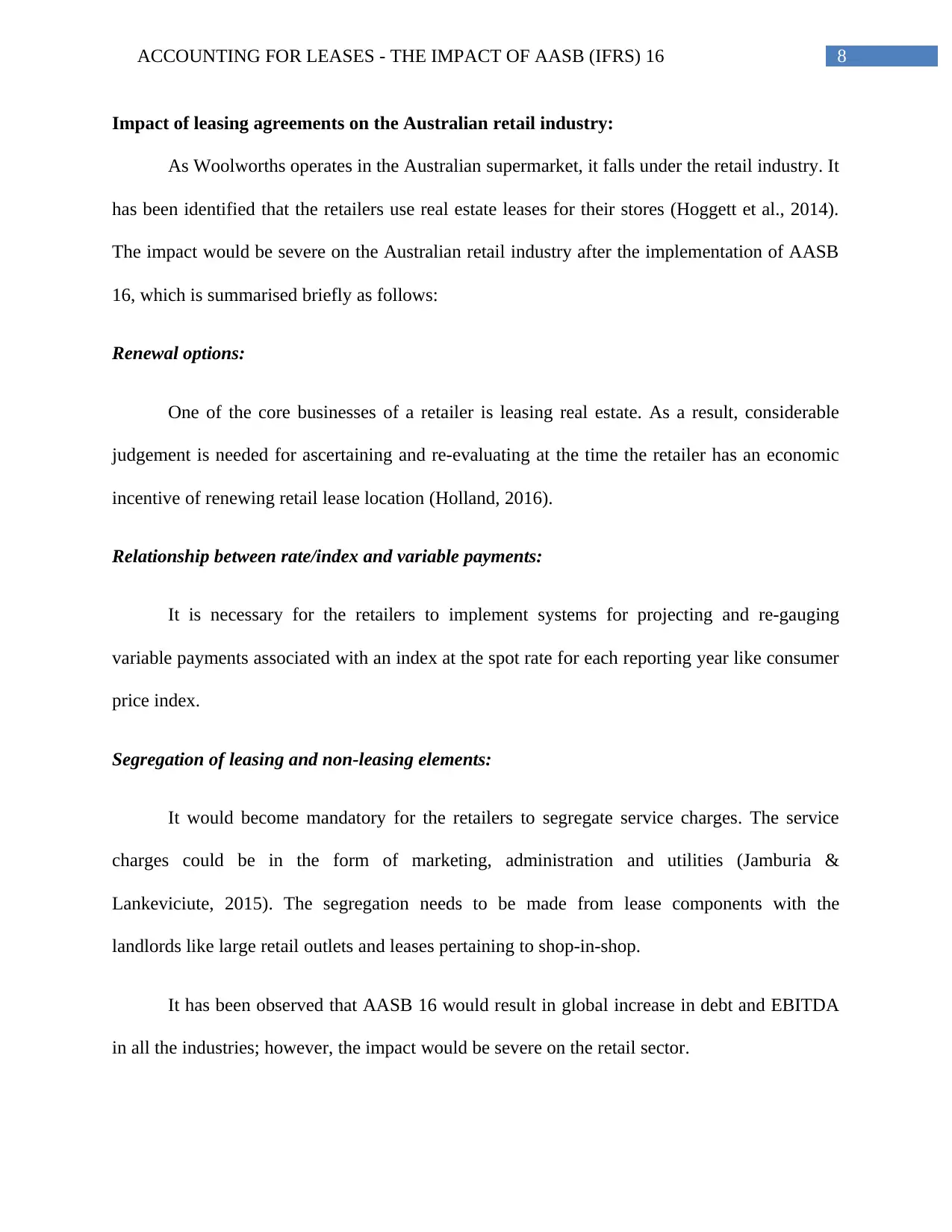
8ACCOUNTING FOR LEASES - THE IMPACT OF AASB (IFRS) 16
Impact of leasing agreements on the Australian retail industry:
As Woolworths operates in the Australian supermarket, it falls under the retail industry. It
has been identified that the retailers use real estate leases for their stores (Hoggett et al., 2014).
The impact would be severe on the Australian retail industry after the implementation of AASB
16, which is summarised briefly as follows:
Renewal options:
One of the core businesses of a retailer is leasing real estate. As a result, considerable
judgement is needed for ascertaining and re-evaluating at the time the retailer has an economic
incentive of renewing retail lease location (Holland, 2016).
Relationship between rate/index and variable payments:
It is necessary for the retailers to implement systems for projecting and re-gauging
variable payments associated with an index at the spot rate for each reporting year like consumer
price index.
Segregation of leasing and non-leasing elements:
It would become mandatory for the retailers to segregate service charges. The service
charges could be in the form of marketing, administration and utilities (Jamburia &
Lankeviciute, 2015). The segregation needs to be made from lease components with the
landlords like large retail outlets and leases pertaining to shop-in-shop.
It has been observed that AASB 16 would result in global increase in debt and EBITDA
in all the industries; however, the impact would be severe on the retail sector.
Impact of leasing agreements on the Australian retail industry:
As Woolworths operates in the Australian supermarket, it falls under the retail industry. It
has been identified that the retailers use real estate leases for their stores (Hoggett et al., 2014).
The impact would be severe on the Australian retail industry after the implementation of AASB
16, which is summarised briefly as follows:
Renewal options:
One of the core businesses of a retailer is leasing real estate. As a result, considerable
judgement is needed for ascertaining and re-evaluating at the time the retailer has an economic
incentive of renewing retail lease location (Holland, 2016).
Relationship between rate/index and variable payments:
It is necessary for the retailers to implement systems for projecting and re-gauging
variable payments associated with an index at the spot rate for each reporting year like consumer
price index.
Segregation of leasing and non-leasing elements:
It would become mandatory for the retailers to segregate service charges. The service
charges could be in the form of marketing, administration and utilities (Jamburia &
Lankeviciute, 2015). The segregation needs to be made from lease components with the
landlords like large retail outlets and leases pertaining to shop-in-shop.
It has been observed that AASB 16 would result in global increase in debt and EBITDA
in all the industries; however, the impact would be severe on the retail sector.
⊘ This is a preview!⊘
Do you want full access?
Subscribe today to unlock all pages.

Trusted by 1+ million students worldwide
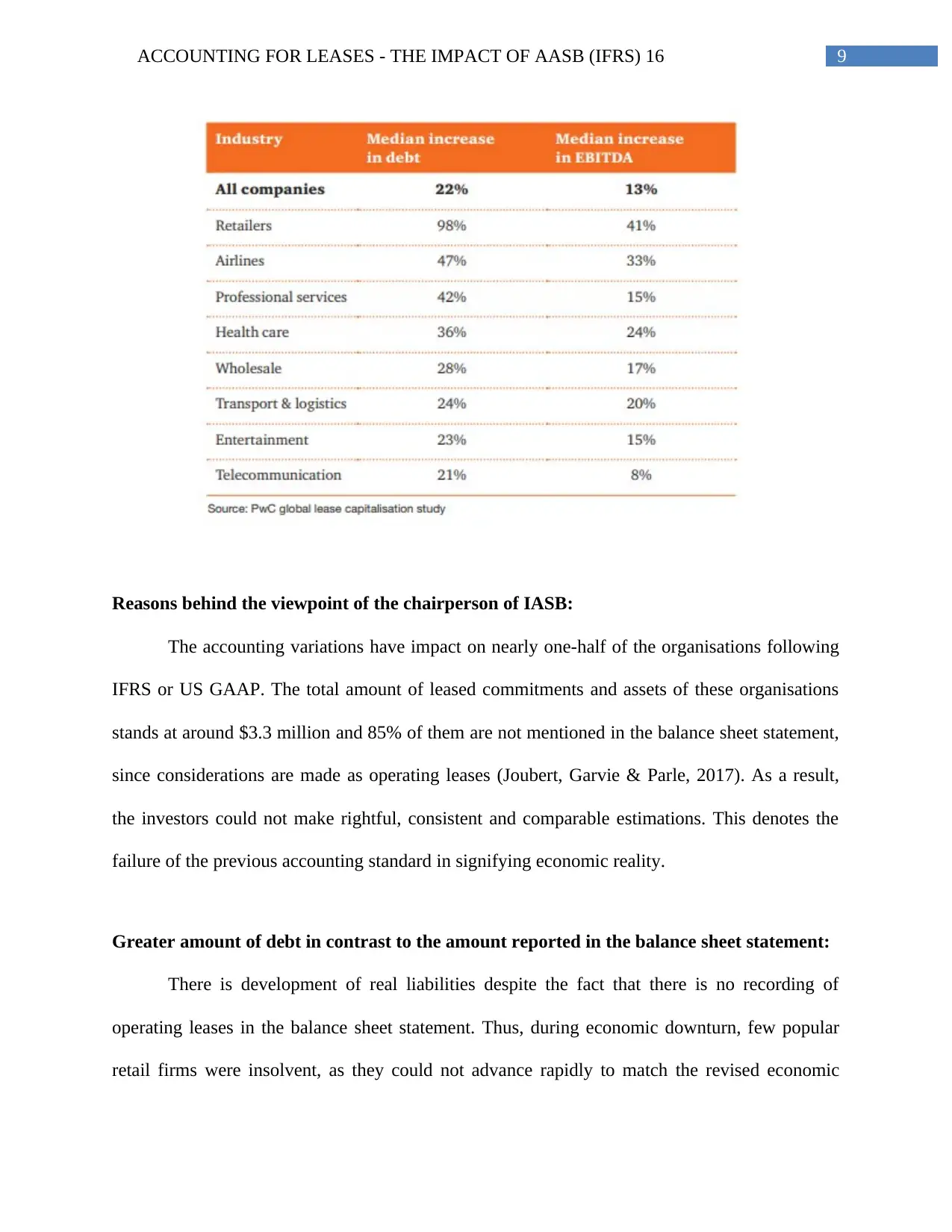
9ACCOUNTING FOR LEASES - THE IMPACT OF AASB (IFRS) 16
Reasons behind the viewpoint of the chairperson of IASB:
The accounting variations have impact on nearly one-half of the organisations following
IFRS or US GAAP. The total amount of leased commitments and assets of these organisations
stands at around $3.3 million and 85% of them are not mentioned in the balance sheet statement,
since considerations are made as operating leases (Joubert, Garvie & Parle, 2017). As a result,
the investors could not make rightful, consistent and comparable estimations. This denotes the
failure of the previous accounting standard in signifying economic reality.
Greater amount of debt in contrast to the amount reported in the balance sheet statement:
There is development of real liabilities despite the fact that there is no recording of
operating leases in the balance sheet statement. Thus, during economic downturn, few popular
retail firms were insolvent, as they could not advance rapidly to match the revised economic
Reasons behind the viewpoint of the chairperson of IASB:
The accounting variations have impact on nearly one-half of the organisations following
IFRS or US GAAP. The total amount of leased commitments and assets of these organisations
stands at around $3.3 million and 85% of them are not mentioned in the balance sheet statement,
since considerations are made as operating leases (Joubert, Garvie & Parle, 2017). As a result,
the investors could not make rightful, consistent and comparable estimations. This denotes the
failure of the previous accounting standard in signifying economic reality.
Greater amount of debt in contrast to the amount reported in the balance sheet statement:
There is development of real liabilities despite the fact that there is no recording of
operating leases in the balance sheet statement. Thus, during economic downturn, few popular
retail firms were insolvent, as they could not advance rapidly to match the revised economic
Paraphrase This Document
Need a fresh take? Get an instant paraphrase of this document with our AI Paraphraser
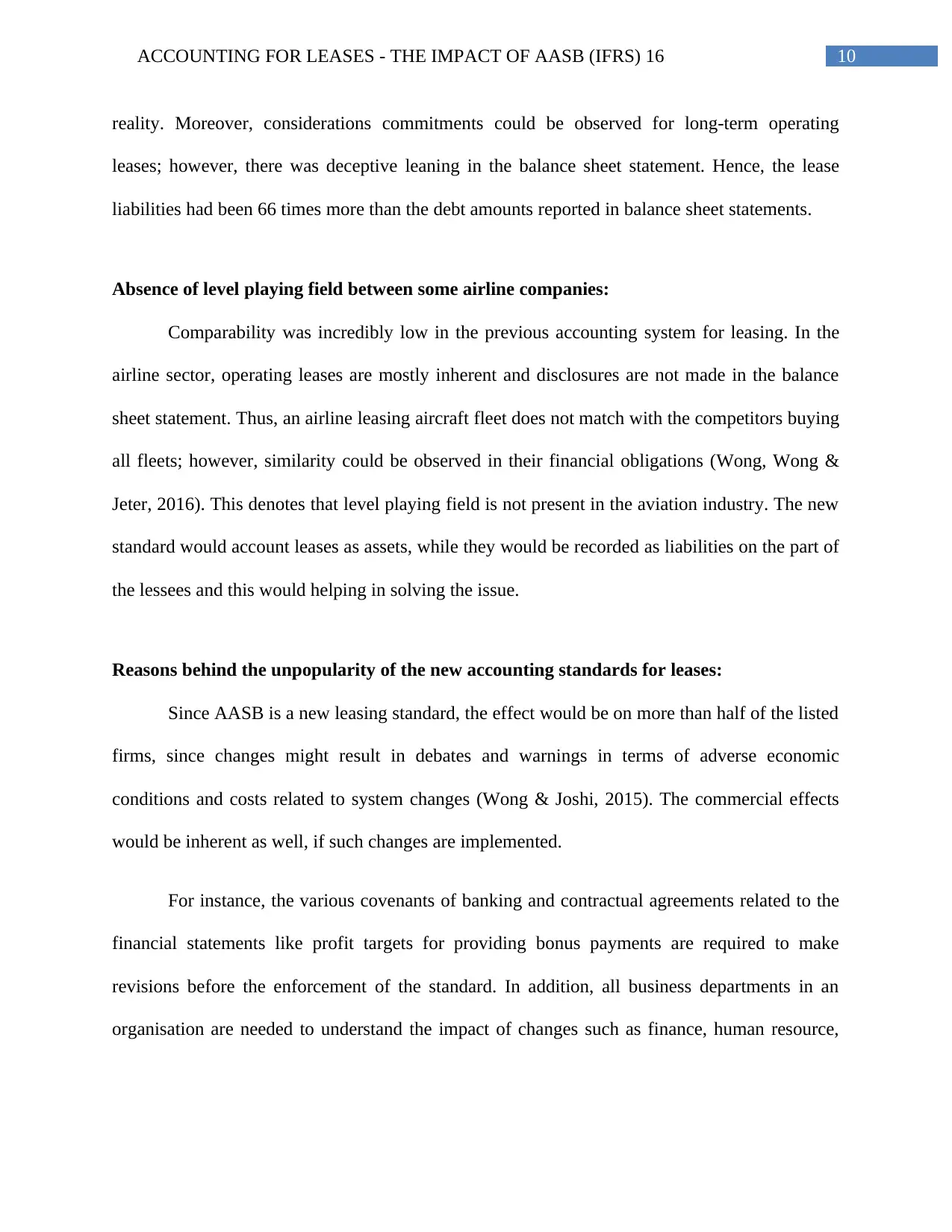
10ACCOUNTING FOR LEASES - THE IMPACT OF AASB (IFRS) 16
reality. Moreover, considerations commitments could be observed for long-term operating
leases; however, there was deceptive leaning in the balance sheet statement. Hence, the lease
liabilities had been 66 times more than the debt amounts reported in balance sheet statements.
Absence of level playing field between some airline companies:
Comparability was incredibly low in the previous accounting system for leasing. In the
airline sector, operating leases are mostly inherent and disclosures are not made in the balance
sheet statement. Thus, an airline leasing aircraft fleet does not match with the competitors buying
all fleets; however, similarity could be observed in their financial obligations (Wong, Wong &
Jeter, 2016). This denotes that level playing field is not present in the aviation industry. The new
standard would account leases as assets, while they would be recorded as liabilities on the part of
the lessees and this would helping in solving the issue.
Reasons behind the unpopularity of the new accounting standards for leases:
Since AASB is a new leasing standard, the effect would be on more than half of the listed
firms, since changes might result in debates and warnings in terms of adverse economic
conditions and costs related to system changes (Wong & Joshi, 2015). The commercial effects
would be inherent as well, if such changes are implemented.
For instance, the various covenants of banking and contractual agreements related to the
financial statements like profit targets for providing bonus payments are required to make
revisions before the enforcement of the standard. In addition, all business departments in an
organisation are needed to understand the impact of changes such as finance, human resource,
reality. Moreover, considerations commitments could be observed for long-term operating
leases; however, there was deceptive leaning in the balance sheet statement. Hence, the lease
liabilities had been 66 times more than the debt amounts reported in balance sheet statements.
Absence of level playing field between some airline companies:
Comparability was incredibly low in the previous accounting system for leasing. In the
airline sector, operating leases are mostly inherent and disclosures are not made in the balance
sheet statement. Thus, an airline leasing aircraft fleet does not match with the competitors buying
all fleets; however, similarity could be observed in their financial obligations (Wong, Wong &
Jeter, 2016). This denotes that level playing field is not present in the aviation industry. The new
standard would account leases as assets, while they would be recorded as liabilities on the part of
the lessees and this would helping in solving the issue.
Reasons behind the unpopularity of the new accounting standards for leases:
Since AASB is a new leasing standard, the effect would be on more than half of the listed
firms, since changes might result in debates and warnings in terms of adverse economic
conditions and costs related to system changes (Wong & Joshi, 2015). The commercial effects
would be inherent as well, if such changes are implemented.
For instance, the various covenants of banking and contractual agreements related to the
financial statements like profit targets for providing bonus payments are required to make
revisions before the enforcement of the standard. In addition, all business departments in an
organisation are needed to understand the impact of changes such as finance, human resource,
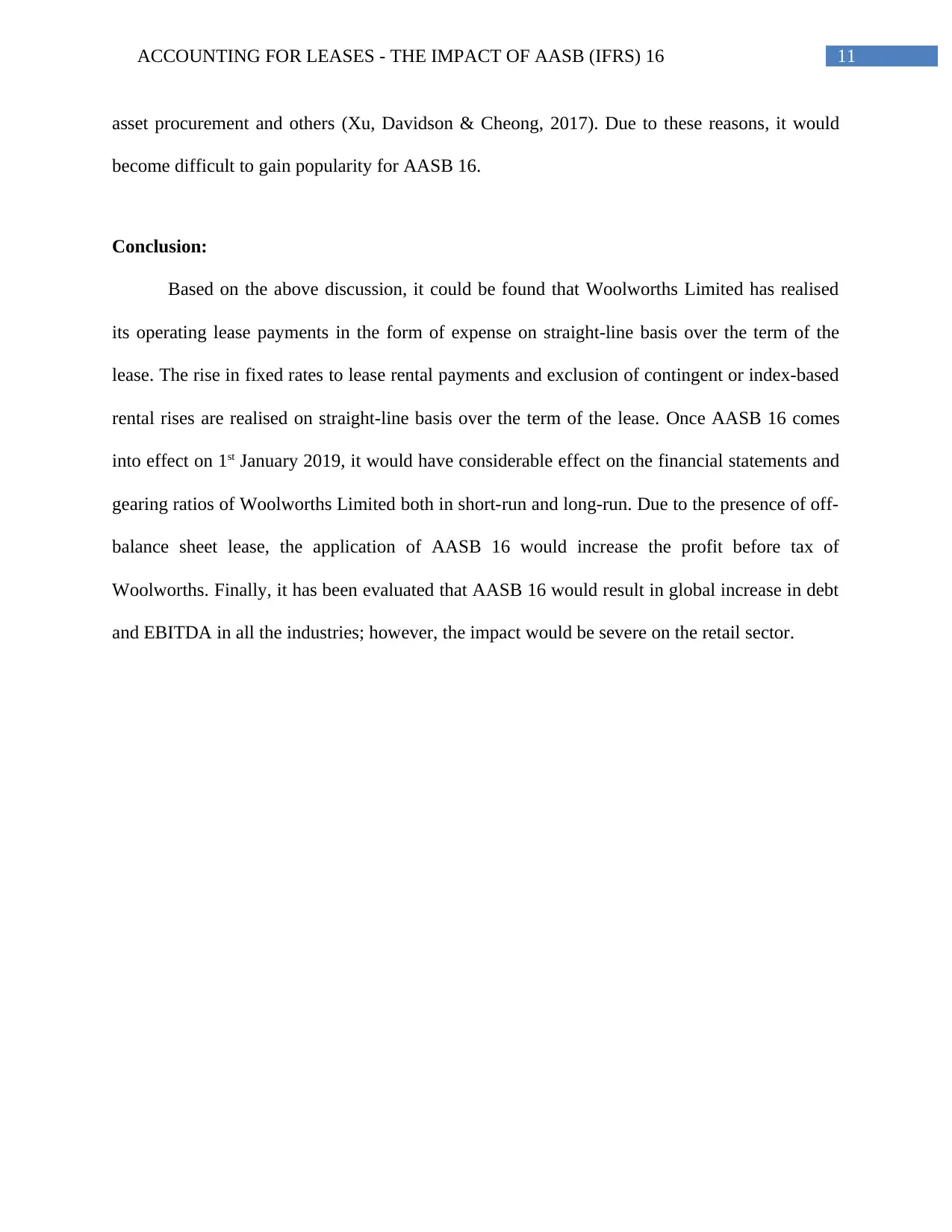
11ACCOUNTING FOR LEASES - THE IMPACT OF AASB (IFRS) 16
asset procurement and others (Xu, Davidson & Cheong, 2017). Due to these reasons, it would
become difficult to gain popularity for AASB 16.
Conclusion:
Based on the above discussion, it could be found that Woolworths Limited has realised
its operating lease payments in the form of expense on straight-line basis over the term of the
lease. The rise in fixed rates to lease rental payments and exclusion of contingent or index-based
rental rises are realised on straight-line basis over the term of the lease. Once AASB 16 comes
into effect on 1st January 2019, it would have considerable effect on the financial statements and
gearing ratios of Woolworths Limited both in short-run and long-run. Due to the presence of off-
balance sheet lease, the application of AASB 16 would increase the profit before tax of
Woolworths. Finally, it has been evaluated that AASB 16 would result in global increase in debt
and EBITDA in all the industries; however, the impact would be severe on the retail sector.
asset procurement and others (Xu, Davidson & Cheong, 2017). Due to these reasons, it would
become difficult to gain popularity for AASB 16.
Conclusion:
Based on the above discussion, it could be found that Woolworths Limited has realised
its operating lease payments in the form of expense on straight-line basis over the term of the
lease. The rise in fixed rates to lease rental payments and exclusion of contingent or index-based
rental rises are realised on straight-line basis over the term of the lease. Once AASB 16 comes
into effect on 1st January 2019, it would have considerable effect on the financial statements and
gearing ratios of Woolworths Limited both in short-run and long-run. Due to the presence of off-
balance sheet lease, the application of AASB 16 would increase the profit before tax of
Woolworths. Finally, it has been evaluated that AASB 16 would result in global increase in debt
and EBITDA in all the industries; however, the impact would be severe on the retail sector.
⊘ This is a preview!⊘
Do you want full access?
Subscribe today to unlock all pages.

Trusted by 1+ million students worldwide
1 out of 14
Related Documents
Your All-in-One AI-Powered Toolkit for Academic Success.
+13062052269
info@desklib.com
Available 24*7 on WhatsApp / Email
![[object Object]](/_next/static/media/star-bottom.7253800d.svg)
Unlock your academic potential
Copyright © 2020–2025 A2Z Services. All Rights Reserved. Developed and managed by ZUCOL.





